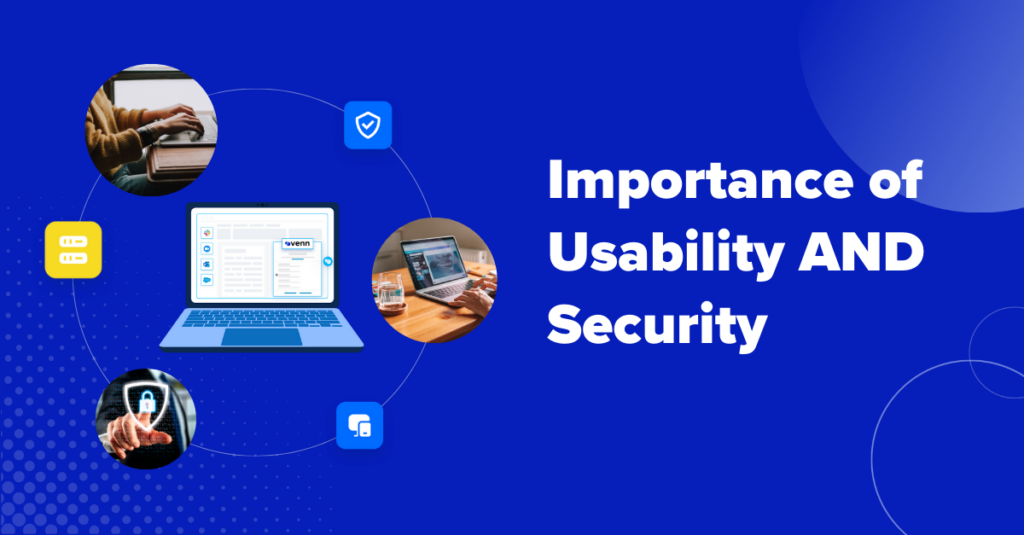The popularity and utility of remote work makes the debate between usability and security more relevant than ever. And with more companies embracing BYOD, they must provide tools that safeguard sensitive information but that are also easy and, dare I say, pleasant for their employees to use. Striking a balance between security and usability also has a big impact on your team’s overall productivity and employee satisfaction.
Understanding the Trade-Offs
Usability and security are almost always at odds. Highly secure systems tend to involve complex authentication processes and restrictive controls that can frustrate users, leading to reduced productivity and potential non-compliance with security protocols. On the other hand, user-friendly interfaces that simplify tasks and reduce the need to make constant security-minded decisions can sometimes compromise rigorous security measures. But this trade-off isn’t set in stone. Modern solutions that support BYOD, or the use of personal devices for work, are showing that it’s possible to design systems that are both secure and easy to use.
Real-world examples of existing solutions and security features include:
- VPN Access offers crucial encryption and anonymity for remote work, but it has drawbacks. Its auto-connect feature may engage unnecessarily, using up bandwidth and slowing down other apps. Its location-aware adjustments depend on precise data, which can misfire and apply incorrect security settings. Finally, a VPN experience may obscure issues like network instability or breaches.
- Intuitive Multi-Factor Authentication (MFA) with biometric verification significantly boosts security by reducing unauthorized access risks. Still, it can misidentify legitimate users due to variable conditions like poor lighting or dirty fingers, potentially causing lockouts and workflow disruptions. Also, compromised biometric data poses a permanent security threat as it cannot be changed.
- Smart Collaboration Tools use end-to-end encryption and user-friendly interfaces to secure data without disrupting productivity. Yet, they require constant updates to stay ahead of new threats and may simplify features excessively, leading to potential security gaps. These tools could also lead to overreliance, opening up the possibility that users might share sensitive information unsafely.
- Virtual Desktops create isolated environments for work applications, yet they introduce risks such as hypervisor vulnerabilities that could compromise all virtual machines if not properly managed. They also demand high-performance hardware, which could degrade device usability.
- Enterprise Browsers operate as secure, managed web browsing solutions tailored for organizational use. They enforce IT policies, control resource access, and provide monitoring capabilities for enhanced security for any app that can run inside a browser. Locally installed applications like slack, office, zoom and others would not be supported. Learning a new browser could be a challenge for some users, causing them to seek workarounds.
- A Secure Enclave operates to secure contractors and employees working on unmanaged or BYOD computers. Similar to an MDM solution but for laptops – work lives in a company-controlled Secure Enclave installed on the user’s computer, where all data is encrypted and access is managed. Work applications run locally within the Enclave, isolating and protecting business activity from any personal use on the same computer. Company data is secured without controlling the entire device, while ensuring end-user privacy.
So, while these technologies offer substantial benefits by enhancing security and improving user experience, some can bring challenges or gaps. Organizations must be proactive in understanding their unique use cases and whether there are unique compliance regulations to consider. This will help guide them in understanding which solutions will work best for them. It’s important to address the challenges associated with advanced security solutions to fully benefit from their advantages while minimizing risks.
Safeguarding Personal Boundaries in BYOD Workforces
Maintaining the separation between personal and professional lives is a constant challenge in environments that utilize Bring Your Own Device (BYOD) policies. Organizations with remote employees, contractors and offshore workers that are using their personal devices must respect and protect their employees’ privacy while also ensuring that corporate data is secure.
But when employees use their personal devices for work purposes, concerns about privacy invasion naturally arise. These concerns are justified as corporate security measures can often be perceived as overly intrusive if not managed correctly. Employees generally oppose having their personal communications, data, or activities monitored or controlled by their employers. Addressing this issue requires a thoughtful approach that upholds personal boundaries without sacrificing security.
Best Practices for Better BYOD Privacy
Organizations should establish clear BYOD policies that explicitly define the boundaries of monitoring and management. Such guidelines should clarify what is private and what is under corporate oversight, thereby building trust with employees. Additionally, policies should specifically state that personal data on devices will not be accessed, monitored, or retrieved unless it is done with prior consent.
Regular security audits are also essential for protecting both corporate and personal data. These audits should be conducted in a manner that respects employee privacy, utilizing automated tools that ensure compliance without exposing personal details.
By implementing these measures and maintaining thoughtful policies, organizations can effectively safeguard employee privacy while still enforcing robust security measures. This balanced approach not only meets compliance and data protection standards but also cultivates a culture of trust and respect, which are vital for the success of any remote work strategy.
Enhancing Productivity and Security Through Design
Effective user experience (UX) design in remote work security tools on BYOD is critical, not merely for aesthetics but also for ensuring that these tools are utilized properly. Poorly designed interfaces can lead to frustration, decreased productivity, and potential security risks as employees might seek simpler yet less secure alternatives.
Challenges in Security Tool Design
When using their own personal devices, complex or non-intuitive security tools can overwhelm users, potentially leading to non-compliance or misuse. If security processes are too cumbersome, employees may bypass them, heightening the risk of breaches. Tools that are slow, unresponsive, or not compatible with preferred operating systems can disrupt work, waste time, and reduce overall productivity. And, when official tools fail to meet user needs, employees may turn to unauthorized, less secure software, known as “shadow IT,” which can actually increase the risk of introducing security threats.
Strategies for Optimizing UX in Security Tools
Organizations should prioritize user-centric design in the development or purchase decisions of their BYOD security tools. This involves engaging with end-users during the design and testing phases to provide intuitive interfaces that meet real workforce needs. Implementing feedback loops can further refine these tools, enhancing usability without sacrificing security.
Additionally, optimizing tool performance to ensure compatibility and efficiency across various devices and systems is crucial. Tools that impact performance like latency and lagging or that provide an unfamiliar experience can negatively impact user experience.
By focusing on these design principles, organizations can create security tools that not only protect data but also support a productive and satisfied BYOD workforce.
A Holistic Approach Can Enhance the Remote Work Experience
A holistic approach that combines technical solutions with human-centered strategies can help create a secure and efficient digital workspace for the BYOD workforce. This approach also ensures that employees feel supported and remain engaged while maintaining your security standards throughout. It can also enhance the quality of work-life balance through flexible working hours, mental health breaks, and remote-accessible well-being programs that help foster a productive, collaborative remote work environment.
- Design tools and policies that respond to employee needs and preferences, which helps minimize cognitive load and boost job satisfaction.
- Pick technologies that enhance rather than disrupt employee workflows to avoid turning security measures into productivity obstacles.
- Solicit regular feedback from all organizational levels to continuously refine tools and policies, ensuring they meet evolving needs and conditions.
- Protect and respect privacy, especially under BYOD policies, through clear guidelines that separate personal from professional data.
By embracing a comprehensive, holistic approach, your organization can ensure that its remote work practices secure data, boost employee morale, and successfully adapt to future challenges, thereby creating a dynamic and resilient digital workplace.
To learn more about how IT teams can easily secure and support BYOD workforces without the cost, complexity, and usability challenges, reach out to us and we can show you how Venn’s Blue Border and the Secure Enclave could work for your organization.



